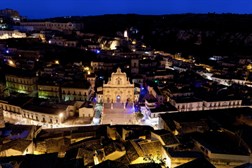Modica
 Like many other towns in Sicily, Modica boasts ancient origins, dating, according to the most recent studies, from the fourteenth century B.C. It was first inhabited by the Sicanians, then by the Phoenicians, Sicilians, Greeks, Romans and Arabs. In 1296, Manfredi Chiaramonte was appointed by King Frederick II of Aragon, as Count of Modica. The Chiaramonte strongly tied their name to the city for all the final phase of the Middle Ages, and the County of Modica became one of the most important feudal states of the entire south, as well as the Kingdom of Sicily. One of the darkest episodes in the history of the town occurred in 1474, with the massacre of about 360 Jews on the day of the feast of the Assumption. In 1481, the county of Modica became a possession of the Spanish family of the Enríquez de Cabrera, holders of the important title of Almirantes de Castilla. The city established itself as a landmark on the cultural level through the presence of numerous educational institutions, both secular and ecclesiastical. Religious Orders like the Dominicans and the Carmelites established centres of studies there since the fourteenth and fifteenth centuries, but in the sixteenth century there was also a certified public school and the Friars Minor Observants had schools there. The Jesuits founded a college in Modica in 1630 which remained active until 1767. A watershed event in the history of the town was the great earthquake of 11 January 1693, which caused more than 3,000 casualties and extensive damage to its artistic and architectural heritage. The reconstruction, albeit partial (the city had not been completely razed to the ground as had happened to other towns in the area), made of Modica one of the symbols of the late-Baroque of the Val di Noto. The last heirs of the county were the Álvarez de Toledo and the Fitz-James Stuart, until the abolition of feudalism in 1812.
Like many other towns in Sicily, Modica boasts ancient origins, dating, according to the most recent studies, from the fourteenth century B.C. It was first inhabited by the Sicanians, then by the Phoenicians, Sicilians, Greeks, Romans and Arabs. In 1296, Manfredi Chiaramonte was appointed by King Frederick II of Aragon, as Count of Modica. The Chiaramonte strongly tied their name to the city for all the final phase of the Middle Ages, and the County of Modica became one of the most important feudal states of the entire south, as well as the Kingdom of Sicily. One of the darkest episodes in the history of the town occurred in 1474, with the massacre of about 360 Jews on the day of the feast of the Assumption. In 1481, the county of Modica became a possession of the Spanish family of the Enríquez de Cabrera, holders of the important title of Almirantes de Castilla. The city established itself as a landmark on the cultural level through the presence of numerous educational institutions, both secular and ecclesiastical. Religious Orders like the Dominicans and the Carmelites established centres of studies there since the fourteenth and fifteenth centuries, but in the sixteenth century there was also a certified public school and the Friars Minor Observants had schools there. The Jesuits founded a college in Modica in 1630 which remained active until 1767. A watershed event in the history of the town was the great earthquake of 11 January 1693, which caused more than 3,000 casualties and extensive damage to its artistic and architectural heritage. The reconstruction, albeit partial (the city had not been completely razed to the ground as had happened to other towns in the area), made of Modica one of the symbols of the late-Baroque of the Val di Noto. The last heirs of the county were the Álvarez de Toledo and the Fitz-James Stuart, until the abolition of feudalism in 1812.
